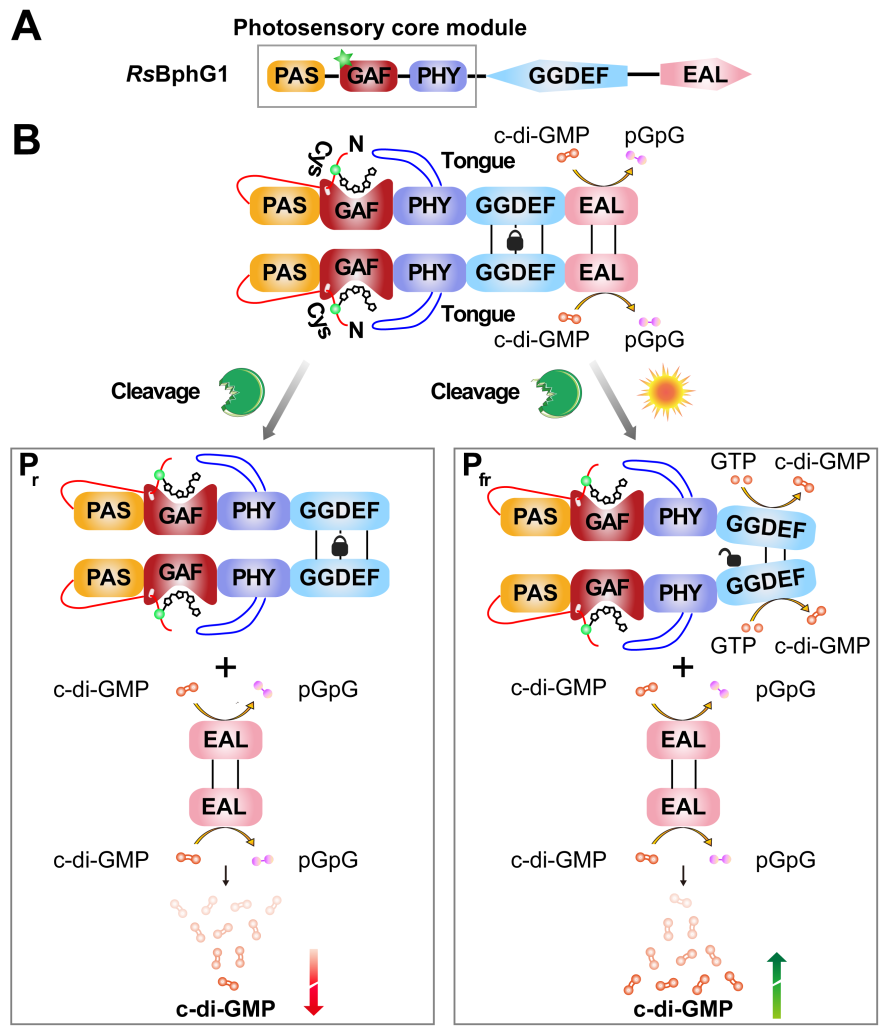南湖新闻网讯(通讯员 张维)近日,国际期刊FEMS Microbiology Reviews上在线发表了由我校农业微生物资源发掘与利用全国重点实验室、湖北洪山实验室何进教授研究团队所撰写的综述论文:“Gas and light: triggers of c-di-GMP-mediated regulation”,该论文总结了c-di-GMP代谢酶感知气体和光信号的调控方式和具体机制,对c-di-GMP信号转导通路的完善具有重要指导意义。
第二信使(Second messenger)系统是细菌为了适应不断变化的环境条件所进化出的一类信号转导系统,能够帮助细菌监测外界各类环境参数的变化并迅速作出响应。当细胞表面的受体接收到细胞外信号(可以称为“第一信使(first messenger)”)时,细菌会随之调节胞内各种合成酶与水解酶的催化活性,进而改变第二信使分子的浓度。此后,相关受体分子(包括蛋白类受体与RNA类受体)通过感知第二信使分子浓度的变化,对关键酶或代谢途径进行调节,从而调控细菌多种生理功能。在该过程中,第二信使能够作为“桥梁”协助细菌响应无法直接内化的胞外初始信号(第一信使),帮助细菌在信号感知与细胞反应之间建立转换。
第二信使主要可分为四类,而占主要地位的为核苷类第二信使,它们通常是一些不用于细胞核酸合成的特异性核苷酸,例如cAMP、cGMP、c-di-AMP、c-di-GMP、c-GAMP、(p)ppGpp等。其中,c-di-GMP是一类广泛存在于细菌中的第二信使分子,其合成与降解分别受到合成酶——二鸟苷酸环化酶(DGC)以及水解酶——c-di-GMP特异性磷酸二酯酶(PDE)的调控。大量研究表明,c-di-GMP参与调节细菌生物被膜的形成、细菌运动性、细胞发育、压力对抗性等过程。近十年来,何进教授课题组一直致力于c-di-GMP等多种核苷类第二信使分子调控通路的研究,并在此领域取得了一系列研究进展。
何进教授团队注意到,目前关于c-di-GMP的研究多集中于该信号转导通路的下游,如c-di-GMP调控网络的挖掘和新型受体的鉴定上,但关于c-di-GMP代谢酶如何响应上游信号刺激的研究尚很有限。这种研究趋势忽略了细菌DGC/PDE信号感知的重要性,导致c-di-GMP信号转导网络的研究并不完善。

一氧化氮通过H-NOX结构域诱导生物被膜扩散或形成的机制

光感受器蛋白RsBphG1响应光照调节球形红杆菌c-di-GMP水平的机制
何进教授团队花费三年多的时间,针对c-di-GMP代谢酶感知气体或光信号的相关结构域进行了深入地比较分析,揭示了它们的结构类型和分布情况,并根据文献总结/推测了相关环境信号调节c-di-GMP信号通路的机制。值得一提的是,该综述论文还分析比较了具有相同气体/光感应功能的感知结构域之间的差异和联系,评估了它们在细菌中的特定生理功能和角色定位,对未来该领域的研究工作具有重要的指导意义。该综述不仅弥补了此前c-di-GMP研究领域的缺憾,可促进c-di-GMP调控网络的丰富和完善,还能为药物设计提供新靶点,为生物传感研究带来新思路。
该论文第一作者为我校生命科学技术学院2022届博士毕业生於钊庆,何进教授为本篇论文的通讯作者。我校生命科学技术学院研究生张维、阳鹤,美国国立卫生研究院国家生物技术信息中心Michael Y. Galperin教授及台湾中兴大学教授/我校兼职教授周三和为论文的共同作者。本研究得到了中国国家自然科学基金及美国NIH Intramural Research Program等基金的资助。
审核人:何进
【英文摘要】
The widespread bacterial second messenger c-di-GMP is responsible for regulating many important physiological functions such as biofilm formation, motility, cell differentiation, and virulence. The synthesis and degradation of c-di-GMP in bacterial cells depend, respectively, on diguanylate cyclases and c-di-GMP-specific phosphodiesterases. Since c-di-GMP metabolic enzymes (CMEs) are often fused to sensory domains, their activities are likely controlled by environmental signals, thereby altering cellular c-di-GMP levels and regulating bacterial adaptive behaviors. Previous studies on c-di-GMP-mediated regulation mainly focused on downstream signaling pathways, mainly including the identification of CMEs, cellular c-di-GMP receptors, and c-di-GMP-regulated processes. The mechanisms of CME regulation by upstream signaling modules received less attention, resulting in a limited understanding of the c-di-GMP regulatory networks. We review here the diversity of sensory domains related to bacterial CME regulation. We specifically discuss those domains that are capable of sensing gaseous or light signals and the mechanisms they use for regulating cellular c-di-GMP levels. It is hoped that this review would help refine the complete c-di-GMP regulatory networks and improve our understanding of bacterial behaviors in changing environments. In practical terms, this may eventually provide a way to control c-di-GMP-mediated bacterial biofilm formation and pathogenesis in general.
论文链接:
https://doi.org/10.1093/femsre/fuad034